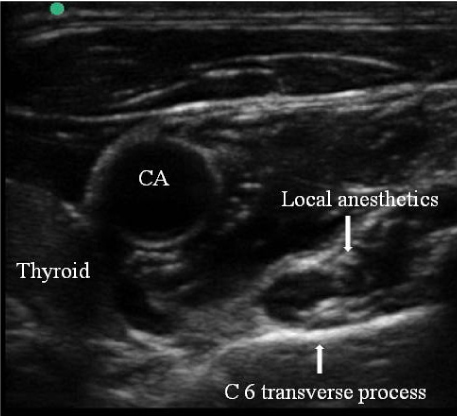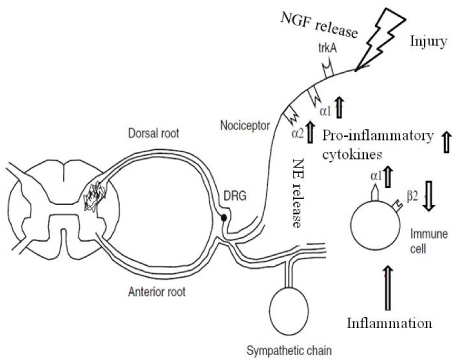J Dent Anesth Pain Med.
2016 Sep;16(3):159-163. 10.17245/jdapm.2016.16.3.159.
Therapeutic potential of stellate ganglion block in orofacial pain: a mini review
- Affiliations
-
- 1Department of Anesthesiology and Pain Medicine, School of Dentistry, Kyungpook National University, Daegu, Korea. jeon68@knu.ac.kr
- KMID: 2354650
- DOI: http://doi.org/10.17245/jdapm.2016.16.3.159
Abstract
- Orofacial pain is a common complaint of patients that causes distress and compromises the quality of life. It has many etiologies including trauma, interventional procedures, nerve injury, varicella-zoster (shingles), tumor, and vascular and idiopathic factors. It has been demonstrated that the sympathetic nervous system is usually involved in various orofacial pain disorders such as postherpetic neuralgia, complex regional pain syndromes, and atypical facial pain. The stellate sympathetic ganglion innervates the head, neck, and upper extremity. In this review article, the effect of stellate ganglion block and its mechanism of action in orofacial pain disorders are discussed.
MeSH Terms
Figure
Reference
-
1. Sardella A, Demarosi F, Barbieri C, Lodi G. An up-to-date view on persistent idiopathic facial pain. Minerva Stomatol. 2009; 58:289–299.
Article2. Sarlani E, Balciunas BA, Grace EG. Orofacial pain--Part I: Assessment and management of musculoskeletal and neuropathic causes. AACN Clin Issues. 2005; 16:333–346.
Article3. Melis M, Zawawi K, Badawi E, Lobolobo S, Metha N. Complex regional pain syndrome in the head and neck: A review of the literature. J Orofac Pain. 2002; 16:93–104.
Article4. Wu CL, Marsh A, Dworkin RH. The role of sympathetic nerve blocks in herpes zoster and postherpetic neuralgia. Pain. 2000; 87:121–129.
Article5. Kohjitani A, Miyawaki T, Kasuya K, Shimada M. Sympathetic activity-mediated neuropathic facial pain following simple tooth extraction: A case report. Cranio. 2002; 20:135–138.
Article6. Kang CK, Oh ST, Chung RK, Lee H, Park CA, Cho ZH, et al. Effect of stellate ganglion block on the cerebrovascular system. Anesthesiology. 2010; 113:936–944.7. Treggiari MM, Romand JA, Martin JB, Reverdin A, Rufenacht DA, de Tribolet N. Cervical sympathetic block to reverse delayed ischemic neurological deficits after aneurysmal subarachnoid hemorrhage. Stroke. 2003; 34:961–967.8. Jeong S, Jeon Y, Yeo J, Baek W. The effects of stellate ganglion block on the electroencephalogram in rats. J Anesth. 2014; 28:601–605.
Article9. Yeo J, Jeon Y. Effects of stellate ganglion block on sedation as assessed by bispectral index in normal healthy volunteers. Pain Physician. 2015; 18:173–178.
Article10. Baron R, Janig W, With H. Sympathetic and afferent neurons projecting into forelimb and trunk nerves and the anatomical organization of the thoracic sympathetic outflow of the rat. J Auton Nerv Syst. 1995; 53:205–214.
Article11. Hogan QH, Erickson SJ, Haddox JD, Abram SE. The spread of solution during stellate ganglion block. Regional Anesthesia. 1992; 17:78–83.
Article12. Narouze S. Ultrasound-guided stellate ganglion block: safety and efficacy. Curr Pain Headache Rep. 2014; 18:424.
Article13. Millan MJ. Descending control of pain. Progs Neurobiol. 2002; 66:355–474.
Article14. Maestroni GJ. Sympathetic nervous system influence on the innate immune response. Ann N Y Acad Sci. 2006; 1069:195–207.
Article15. Maestroni GJ. Modulation of skin norepinephrine turnover by allergen sensitization: Impact on contact hypersensitivity and T helper priming. J Invest Dermatol. 2004; 122:119–124.
Article16. Schlereth T, Birklein F. The sympathetic nervous system and pain. Neuromolecular Med. 2008; 10:141–147.
Article17. Westerhaus MJ, Loewy AD. Central representation of the sympathetic nervous system in the central cortex. Brain Res. 2001; 903:117–127.
Article18. Mulvaney SW, McLean B, de Leeuw J. The use of stellate ganglion block in the treatment of panic/anxiety symptoms with combat-related post-traumatic stress disorder; preliminary results of long-term follow-up: a case series. Pain Pract. 2010; 10:359–365.
Article19. Lynch ME, Elgeneidy AK. The role of sympathetic activity in neuropathic orofacial pain. J Orofac Pain. 1996; 10:297–305.
Article20. Lipov EG, Joshi JR, Sanders S, Slavin KV. A unifying theory linking the prolonged efficacy of the stellate ganglion block for the treatment of chronic regional pain syndrome (CRPS), hot flashes, and posttraumatic stress disorder (PTSD). Med Hypotheses. 2009; 72:657–661.21. Salvaggio I, Adducci E, Dell'Aquila L, Rinaldi S, Marini M, Zappia L, et al. Facial pain: a possible therapy with stellate ganglion block. Pain Med. 2008; 9:958–962.22. Matsuura M, Ando F, Sahashi K, Torii Y, Hirose H. The effect of stellate ganglion block on prolonged postoperative ocular pain. Nippon Ganka Gakkai Zasshi. 2003; 107:607–612.
Article23. Jeon YH, Kim JH. Treatment of Atypical Facial Pain with Stellate Ganglion Block. J Korean Dent Soc Anesthesiol. 2014; 14:173–175.
Article24. Jeon Y, Kim D. The effect of stellate ganglion block on the atypical facial pain. J Dent Anesth Pain Med. 2015; 15:35–37.
Article25. Hentschel K, Capobianco DJ, Dodick DW. Facial Pain. Neurologist. 2005; 11:244–249.
Article26. Wang QX, Wang XY, Fu NA, Liu JY, Yao SL. Stellate ganglion block inhibits formalin-induced nociceptive responses: mechanism of action. Eur J Anaesthesiol. 2005; 22:913–918.
Article27. Obermann M, Yoon MS, Esc D, Naschke M, Kaube H, Diener HC, et al. Impared trigeminal nociceptive processing in patients with trigeminal neuralgia. Neurology. 2007; 69:835–841.
Article28. Shanthanna H. Utility of stellate ganglion block in atypical facial pain: a case report and consideration of its possible mechanisms. Case Rep Med. 2013; 2013:293826.29. Walega DR, Smith C, Epstein JB. Bilateral stellate ganglion blockade for recalcitrant oral pain from Burning Mouth Syndrome: a case report. J Oral Facial Pain Headache. 2014; 28:171–175.30. Makharita MY, Amr YM, El-Bayoumy Y. Effect of early stellate ganglion blockade for facial pain from acute herpes zoster and incidence of postherpetic neuralgia. Pain Physician. 2012; 15:467–474.
Article31. Gogia AR, Chandra KN. Stellate ganglion block can relieve symptoms and pain and prevent facial nerve damage. Saudi J Anaesth. 2015; 9:204–206.
Article
- Full Text Links
- Actions
-
Cited
- CITED
-
- Close
- Share
- Similar articles
-
- Thermographic Follow up of the Stellate Ganglion Block: Case Report
- Stellate Ganglion Block for the Treatment of Classic Migraine: A case report
- Stellate Ganglion Block for the Treatment of Primary Dysmenorrhea
- Percutaneous Radiofrequency Thermocoagulation of the Stellate Ganglion in the Treatment of Cervical and Upper Extremity Pain: A case report
- Continuous Stellate Ganglion Block for Raynaud'S Disease



